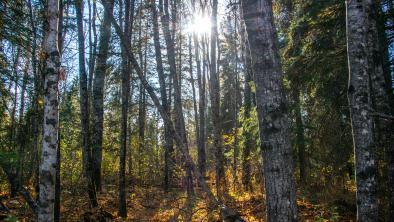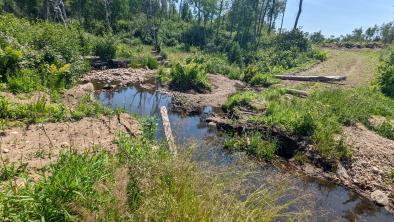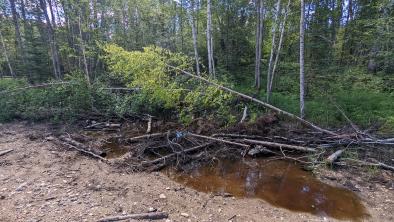Why the Energy East pipeline is actually prohibited in Manitoba

By Eric Reder
Ricochet Media
May 19, 2016
Normally environmental research leads to information about the detrimental effects of a development. As an environmental advocate, I don’t make a grand discovery on every campaign, or even every year. But one Sunday in March, as I contemplated the hiking route for a new guided environmental tour, I realized such a discovery, on arguably thebiggest environmental campaign in Canada.
In the fall of 2014, TransCanada filed an unwieldy 30,000 pages of data on the proposed Energy East pipeline, a 4,600-kilometer-long pipeline that would be the biggest in North America. With download limits and no index in the document, accessing the information — never mind parsing useful pieces of it — was difficult at best.
After days spent skimming the documents for information pertinent to Manitoba, I began focusing on the province's most popular park: Whiteshell Provincial Park in eastern Manitoba. The existing natural gas pipeline corridor that TransCanada wants to convert for tar sands transport runs past Falcon Lake, the epicentre of lake vacations for many Manitobans.
It’s an area that’s familiar to me, because I led the first Energy East Wilderness Committee Witness Tour near Falcon Lake in May 2015. Participants saw how beautiful and rugged Whiteshell Provincial Park is here, and how fast an oil spill in this area would run into the lake.
I was considering the next public hike along the proposed Energy East route west of Winnipeg, which crosses a Wildlife Management Area. WMAs are intact natural parcels of public land scattered across the developed region of Manitoba, which have been set aside by government for wildlife populations. They are protected under The Wildlife Act in Manitoba.
My Sunday night discovery while reading TransCanada’s filing was that the pipeline runs through two parcels of the Whitemud Watershed WMA — which has been protected for more than 15 years.
I wrote to Manitoba’s Minister for Conservation and Water Stewardship — the authority over WMAs — about oil and gas development in protected areas. Until the recent electoral win by the provincial Conservatives, the post was held by NDP MLA Tom Nevakshonoff.
He replied that oil and gas development are not allowed. “The prohibition of oil and gas exploration and development within protected areas of WMAs is captured under ‘any other activity that significantly and adversely affects habitat.’”
A legal agreement for TransCanada to run a natural gas pipeline through these public lands in Manitoba exists. It was signed before construction more than 50 years ago, although no government official has been able to find it for me. Regardless of what the contract says, though, the newer Wildlife Act regulations that protect the Whitemud Watershed WMA don’t allow for oil development.
Converting an old natural gas pipeline to transport heavier-than-water diluted bitumen is a huge development. The risk to the lands and waters is far greater, and far longer lasting, as the product will not naturally dissipate after a leak.
What’s the history behind this?
TransCanada was formed in the 1950s to send the first supply of western natural gas — a previously wasted byproduct of oil production — to the waiting eastern masses. Other companies followed suit, and TransCanada expanded operations. Now five natural gas pipelines run together across Manitoba, transporting fossil fuels.
Before the turn of the millennium, though, the world was waking up to the need to preserve the nature and wilderness around us. In 1990, the Manitoba government signed on to the international goal of protecting 12 per cent of the lands and waters of the province by 2000. Only 3 per cent of Manitoba was protected at this time. New parks and ecological reserves were considered, and First Nations were invited to identify where they wanted their territory protected. As the government slowly worked towards the promised goal, some existing WMAs began to receive legislative protection. About 60 per cent of them are legally protected today.
What does this development mean?
What we have is a contradiction on the legality of the current route for Energy East in Manitoba. While TransCanada has a contract to operate the existing pipeline, any development of that pipeline in a protected area is illegal.
This gives the Manitoba government a legal tool to act on climate, and and prevent the construction of Energy East. I, as well as thousands of others, have written about the folly of further fossil fuel infrastructure development. If we build more infrastructure to get out more oil to be burned, we will fail to protect our climate. People are rising up against burning our future.
The Manitoba government has a choice to make, one that we will not allow to be made in secrecy.
The new premier of Manitoba, Brian Pallister, was a cabinet minister in the Progressive Conservative government that originally protected the Whitemud WMA in the 1990s. Will he change the law, and remove portions of the Whitemud Watershed WMA from legal protection, thus bulldozing the way for TransCanada's Energy East proposal?
Or will he draw a line in the sand hills of west-central Manitoba, stopping Energy East and standing up for our future?
Read the original article here
Photo: (Eric Reder)


